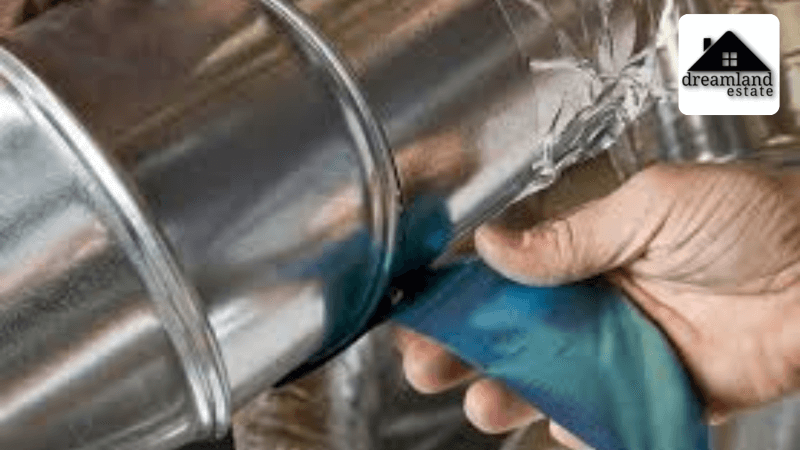HVAC Ductwork Sealing – Your Next DIY Project?

HVAC ductwork delivers conditioned air to all parts of your building. So naturally, for it to carry out that role efficiently, it needs to be in tip-top condition, and that’s where HVAC ductwork sealing comes in.
While it may not occur to you, the ductwork is prone to getting leaks and damage over time.
For example, it’s not uncommon to have rodents in air ducts crawl up and chew away parts or for air to leak through small corners, joints, bends, and other such places around your ductwork. These leaks can cause significant energy loss and drive your heating or cooling costs up!
Fortunately, though, HVAC ductwork sealing can fix that!
What Is HVAC Ductwork Sealing?
Simply put, ductwork sealing involves inspecting, detecting, and then closing up any leaks around ducts that may allow conditioned air to escape through them.
Of course, before you can get to the actual process of sealing ducts, you’ll first need to be sure that the ductwork is leaking and what areas need the most work.
Several signs can help you identify problems with your ductwork, such as unusually high utility bills or uneven heating or cooling in some parts. Whistling or whooshing sounds when air is sucked in or pushed out of vents and visible tears or damage in the ductwork can also indicate trouble.
If you are experiencing any of these issues, it might be time to consult an HVAC professional or look up ways to do HVAC ductwork sealing yourself. If you choose to do it yourself, you’ll first need to inspect the ductwork.
Here is how you can start.
How To Inspect Air Leakage In The Duct Tape?
First, you’ll need some tools, and you’ll need to have some basic understanding.
1. What You Will Need?
Some of the things you’ll require are a screwdriver, a high-power flashlight, a camera (better if it’s a digital camera, but any regular smartphone with a flash will do), and some rags. In addition, it’s essential to wear protective disposable clothing and rubber gloves.
You’ll also need HVAC foil tape (which is different from duct tape) or mastic sealant that’s made specifically for ductwork.
2. Where To Start?
Start by inspecting the main unit and its large ducts. These larger ducts are then connected to branch ducts that run throughout your space. The branch ducts bring air to and carry it from the central system to the rest of the house.
To check for air leaks in this area, turn your HVAC system on and feel for drafts around the connection points. You can get your hands wet to make them more sensitive to whooshing air.
Alternatively, you can use thin tissue paper or an incense stick to check for leaks. Slowly trace the lit incense stick or the tissue paper along the length of the ducts, and if the tissue or sticks blow away or the smoke moves, you have leaking ductwork!
Next, inspect the branch ducts. If you have any visible ductwork in your homes, such as in the basement or attic, check these.
Closely examine the insulation for any signs of damage, dampness, or mold growth which can usually indicate a problem and need other maintenance along with HVAC ductwork sealing. Damaged or wet insulation can also raise concerns about air quality in that area.
3 Duct Sealing Methods
Once you’ve identified any leaks in your home’s ductwork, you can now start sealing it. There are three main ways that HVAC ductwork sealing works, and we’ll go over them one by one.
1. Duct Sealing Tape
HVAC duct sealing tape, also known as aluminum foil tape, is readily available in any hardware store. You can use this duct sealing tape as a quick and mess-free way to seal leaks in ductwork.
However, this method doesn’t last very long and isn’t very good in performance, especially if your ducts get dirty or oily often. Also, it’s essential that duct sealing tape is different from regular duct tape since the latter is neither fire nor smoke rated and won’t hold up for very long.
2. Mastic Sealant Duct
Mastic duct sealant is a gooey substance that hardens after applying to your ducts. These sealants are water-based, making them an excellent choice because they clean up with an easier process and last a longer period.
This method of HVAC duct sealing is pretty simple, and you can easily do it yourself by applying the sealant to any crevices with a paintbrush. Professionals sometimes use caulk guns to apply mastic sealant, but this isn’t necessary.
If you plan on sealing up more significant gaps, like those bigger than ¼ of an inch, with this material, you might have to mix it with another product such as fiberglass.
Mastic duct sealant is different from the regular duct seal material that you use outside your home to close gaps around electric wires and all.
3. Aeroseal Duct Sealant
If you have old ductwork that is near impossible to repair or replace, you might want to consider getting an aeroseal treatment done by a professional.
This high-tech HVAC ductwork sealing method involves blocking all the vents in your house and then using a computer to locate all the leaks in the ductwork.
Once that is done, a mastic sealant is distributed throughout the ducts to fix leaks. While this method is very innovative and precise, it is very costly compared to duct sealing tape and applying mastic sealant with a brush.
How Much Does It Cost to Seal Ductwork?
HVAC ductwork sealing isn’t a costly project if you choose to do it yourself. Duct sealing tape is the cheapest fix, and if you don’t have any leaks in the ductwork, you will most likely only need one roll of tape with some left to spare after.
Mastic duct sealant is slightly more expensive, but you can still get the entire project done for a reasonable cost.
Aeroseal ductwork sealing is the most expensive method, and you can expect to pay anything between $1500 to $4000, but it quickly pays for itself since the energy lost due to leaking ducts is bound to be far more expensive.
Final Thoughts
The health of your ductwork determines the overall efficiency of your HVAC ductwork system. While it’s pretty standard for ducts to get some extent of damage, it’s crucial that you deal with this promptly.
Leaky ducts will not only drive your utility bills through the roof, but they also cause uneven heating around your home and disrupt your comfort.
If you find leaks in your ductwork, you can use one of three popular HVAC duct sealing methods to fix the issue. The cheapest and quickest fix is using duct sealing tape to patch up any gaps in the duct.
A more long-lasting fix is using mastic duct sealant, which is slightly costlier but is an easy DIY project for you to try out. Finally, the most effective method is to seal your ductwork with aeroseal internally, but it will cost you a pretty penny.
Read Also:













Leave A Reply